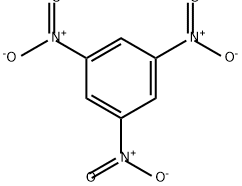1.3.5-트리니트로벤젠 C화학적 특성, 용도, 생산
화학적 성질
Trinitrobenzene is a yellow crystalline solid.
용도
Explosive. 1,3,5-Trinitrobenzene is a vulcanizing agent for natural rubber. Indicator for pH 12.0-14.0.
정의
ChEBI: A trinitrobenzene in which each of the nitro groups is meta- to the other two.
일반 설명
A light yellow crystalline sludge or slurry. Burns but may require some effort to ignite. A high explosive when dry. Easily ignited and burns very vigorously when dry. Soluble in alcohol and ether; insoluble in water. Produces toxic oxides of nitrogen during combustion.
공기와 물의 반응
Insoluble in water.
반응 프로필
Aromatic nitro compounds, such as TRINITROBENZENE, range from slight to strong oxidizing agents. If mixed with reducing agents, including hydrides, sulfides and nitrides, they may begin a vigorous reaction that culminates in a detonation. The aromatic nitro compounds may explode in the presence of a base such as sodium hydroxide or potassium hydroxide even in the presence of water or organic solvents. The explosive tendencies of aromatic nitro compounds are increased by the presence of multiple nitro groups.
건강위험
Some are toxic and may be fatal if inhaled, swallowed or absorbed through skin. Contact may cause burns to skin and eyes. Fire may produce irritating, corrosive and/or toxic gases. Runoff from fire control or dilution water may cause pollution.
화재위험
Trinitrobenzene is a high explosive, similar to trinitrotoluene. However, it is less sensitive to impact than the latter. Its brisance and power are higher than those of TNT. It detonates when heated rapidly. The dry material is highly sensitive to shock and heat.Slow and careful heating of a small amount of material does not cause detonation. Trinitrobenzene is a flammable solid. It reacts vigorously with reducing substances. It emits highly toxic oxides of nitrogen on decomposition.
.
Safety Profile
Poison by ingestion and
intravenous routes. Mutation data reported.
A severe explosion hazard when shocked or
exposed to heat. Trinitrobenzene is
considered a powerful high explosive and
has more shattering power than TNT.
Although it is less sensitive to impact than
TNT, it is not used much because it is
difficult to produce. The complex with
potassium trimethyl stannate explodes at
room temperature. Forms heat-sensitive
explosive complexes with alkyl or aryl
metallates (e.g., lithium or potassium salts of
trimethyl-, triethyl-, or triphenyl-germanate,
-silanate, or -stamate). Can react vigorously
with reducing materials. When heated to
decomposition it emits highly toxic fumes of
NOx and explodes. See also NITRO
COMPOUNDS of AROMATIC
HYDROCARBONS.
Synthesis
One synthesis route of 1,3,5-Trinitrobenzene is through the decarboxylation of 2,4,6-trinitrobenzoic acid (obtained from TNT by oxidation with chromic acid) by heating in aqueous medium.
잠재적 노출
Trinitrobenzene is explosive when dry.
Used as an explosive; as a vulcanizing agent for natural
rubber. Trinitrobenzene may be more powerful than TNT;
and is reported to be less sensitive to impact than TNT.
However it is difficult to produce, and is not used as widely
as TNT.
저장
Storage and shipping are similar to those used for TNT and other high explosives. Trinitrobenzene is stored in a permanent magazine well separatedfrom initiator explosive, combustible and oxidizing materials, and heat sources. It is shipped in metal containers enclosed in wooden boxes or strong siftproof cloth or paper bags in amounts not exceeding 60 lb net weight (NFPA 1997).
운송 방법
UN0214 Trinitrobenzene, dry or wetted with
<30% water, by mass, Hazard Class: 1.1D; Labels:1.1DExplosives
(with a mass explosion hazard); D-Substances
or articles which may mass detonate (with blast and/or
fragment hazard) when exposed to fire. UN1354
Trinitrobenzene, wetted with not <30% water, by mass,
Hazard Class: 4.1; Labels: 4.1-Flammable solid.
Purification Methods
Crystallise it from glacial acetic acid, CHCl3, CCl4, EtOH aqueous EtOH or EtOH/*benzene, after (optionally) heating with dilute HNO3. Dry it in air. Fuse it and crystallise it under vacuum. [Beilstein 5 H 271, 5 I 140, 5 II 203, 5 III 643, 5 IV 754.]
비 호환성
Sensitive to shock and heat. Incompatible
with initiating explosives, combustible materials. Aromatic
nitro compounds, such as trinitrobenzene, range from slight to
strong oxidizing agents. Keep away from strong reducing
agents, including hydrides, alkali metals; aluminium and
other metal powder; phosphorus; sulfides and nitrides, alkaline
material, strong bases; contact may initiate vigorous reactions
that culminates in a detonation. The aromatic nitro
compounds may explode in the presence of a base such as
sodium hydroxide or potassium hydroxide even in the presence
of water or organic solvents. The aromatic nitro
compounds may explode in the presence of a base such as
sodium hydroxide or potassium hydroxide even in the presence
of water or organic solvents. Incompatible with
strong oxidizers (chlorates, nitrates, peroxides, permanganates,
perchlorates, chlorine, bromine, fluorine, etc.); contact
may cause fires or explosions.
폐기물 처리
Consult with environmental
regulatory agencies for guidance on acceptable disposal
practices. Generators of waste containing this contaminant
(≥100 kg/mo) must conform with EPA regulations governing
storage, transportation, treatment, and waste disposal.
Dissolve in a combustible solvent and spray into an incinerator
equipped with afterburner and scrubber.
1.3.5-트리니트로벤젠 준비 용품 및 원자재
원자재
준비 용품












